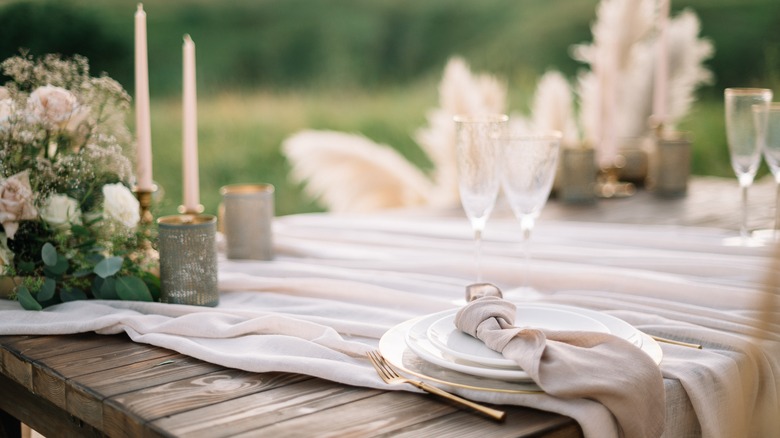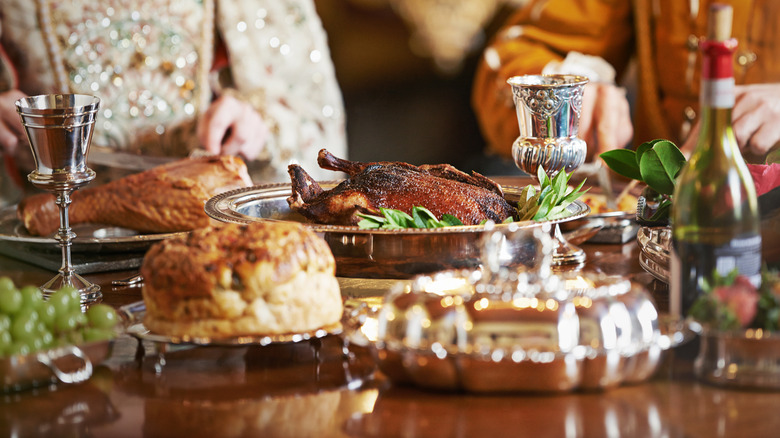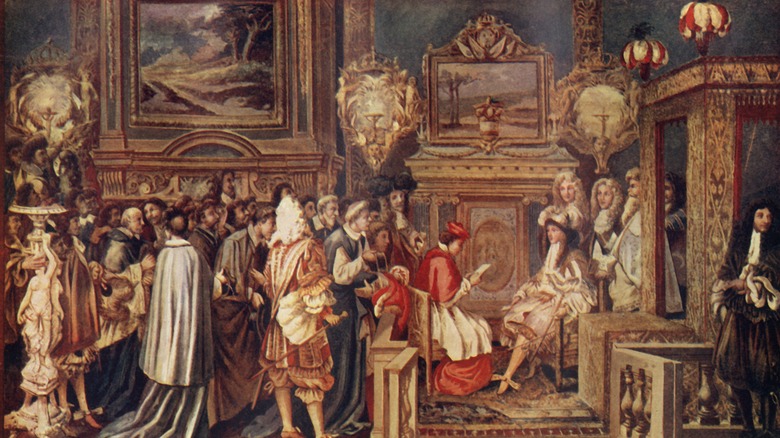Dining Etiquette Has Been Around Far Longer Than You Think
When you were growing up, you may have had a parent or grandparent call you out for things like leaning your elbows on the dinner table, or attempting a "boardinghouse reach" to snag those mashed potatoes three places over. If these quips struck you as old-fashioned, you might have associated them with the etiquette-obsessed early 20th century when the likes of Emily Post espoused recommendations for everything from where to sit guests to where to set cutlery when dining.
But rules and regulations for how to most politely get your day's meal down your gullet stretch way farther back than when Post brought codified manners to America, beyond the prim and proper Victorians, and even earlier than the pomp and circumstance of the pre-Revolution era French royal court. Prescribed dining etiquette dates back as far as 13th-century Europe when knights and courtiers alike were held to the highest standards of courtesy: courtly manners, the predecessor to etiquette.
The history of table manners
Dining etiquette was a big deal in Medieval Europe. Large feasts were conducted with a rigid structure that allowed the dishes to be elegantly displayed, so they could be admired by guests. This spurred on customs like pre-meal handwashing, and having a dedicated food taster to sample a lord's food or drink before they ate to check that the vittles weren't poisoned.
With innovation in book printing allowing the production of mass-produced guides to manners starting in the middle of the 15th century, books like 1477's "The Book of Curtesye" by Frederick James Furnivall laid out the etiquette for knights. It was followed, half a century later, by Count Baldassare Castiglione's 1528 etiquette guide, "The Courtier."
But the word 'etiquette' as we know it actually comes from the French word for ticket, "étiquette." In the 1500s, Spain modeled their concept of "etiqueta" after the French, but they expanded the definition to include courtly conduct. In an interesting twist, this in turn made it back to France, who adopted the meaning, and then to English in the mid-1700s — only English speakers used it to mean any set of acceptable behavior, not just when one was at court.
Royal manners: How we got where we are today
It was in the 1600s that the cult of manners reached its apex. As royal wealth grew, particular customs flourished as aristocrats looked for elaborate rituals to flaunt their riches and fill their hours, otherwise marked by luxurious idleness. Much of the formal dining structure we follow now originated in the decadent court of King Louis XIV in France — where extravagant daily feasts set with increasingly elaborate cutlery and china created a standard for the 'service à la Française,' similar to what we would call 'buffet style' dining today. Oh, and nobles would gather around just to watch the royals eat. We may not set up actual buffets at home to serve our food, but we still use forks, knives, and drink from our own cups.
Records of the growing formality in table manners can be seen in the way dining was depicted in artwork of the Renaissance through the Victorian era. Cutlery, which wasn't widely in use until at least the 18th century, is shown off in exquisite detail in many of these paintings – whether of upper-class home life or grand public feasts. Though it may seem like a small thing, the idea that you shouldn't eat food with your hands has had one of the strongest impacts on Western dining culture. As with many old-fashioned customs we've adapted from 17th or 18th dining etiquette, it speaks to a formality and a certain level of removal from the base animal practice of eating that still affects us to this day.



